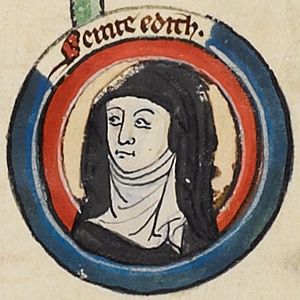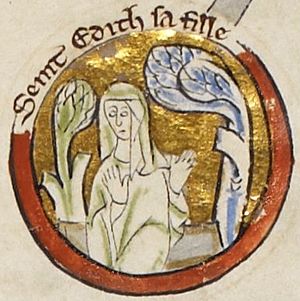Edith of Wilton facts for kids
Quick facts for kids SaintEdith of Wilton |
|
|---|---|

Saint Edith in a 13th-century miniature
|
|
| Born | c. 961 Kemsing, Kent |
| Died | c. 984 Wilton Abbey, England |
| Venerated in | Roman Catholic Church, Anglican Churches, Eastern Orthodox Church |
| Major shrine | Wilton Abbey |
| Feast | 16 September |
| Attributes | Learning, beauty |
| Patronage | Wilton Abbey |
Edith of Wilton (born around 961 – died around 984) was an English saint and nun. She was part of the community at Wilton Abbey. Edith was the daughter of Edgar, King of England (who ruled from 959–975) and Saint Wulfthryth. When Edith was a baby, her mother, Wulfthryth, returned to Wilton Abbey with Edith. Edith and her mother stayed at Wilton for the rest of their lives.
From a young age, Edith chose to live a religious life. She was educated at Wilton Abbey, just like her mother. When she was 15, her father offered her the chance to lead three convents, but she said no. She also refused the English throne in 978 after her half-brother, Edward the Martyr, was killed. Edith died at the age of 23 and was later made a saint.
Contents
Early Life and Family
Edith was born around 961 in Kemsing, Kent, England. Her father was Edgar, King of England, and her mother was Wulfthryth. Wulfthryth was from a noble family and was educated at Wilton Abbey. She later became the abbess (leader) of the abbey. Edith's half-brothers, Edward the Martyr and Æthelred II, both became king after their father.
Historians are not sure about the exact details of Edith's parents' relationship. When Edith was a baby, her parents' relationship ended around 963 or 964. This allowed King Edgar to marry again. Wulfthryth became the abbess of Wilton Abbey shortly after Edith was born.
Choosing a Religious Path
Edith was dedicated to a religious life at Wilton Abbey when she was just two years old. This was a very important event. Her father and other royal officials attended a special ceremony.
A writer named Goscelin, who wrote about Edith's life around 1080, described this moment. He said that when Edith was two, her father showed her beautiful royal clothes and jewels. At the same time, her mother showed her religious items. Goscelin wrote that Edith chose the religious items her mother offered. This story shows how Edith chose a life of faith over royal luxury.
King Edgar made sure Edith received the best education at Wilton. He hired two foreign teachers, Radbod and Benno, to teach her.
Edith's Influence and Choices
A Princess with Power
Even though Edith lived in a convent, she had a lot of influence. People from England and other countries respected her. They would send her letters and gifts. Important church leaders also asked her to speak to the king for them.
Goscelin wrote that Edith could convince her father, King Edgar, to change court decisions. She also helped churches get gifts. People from all parts of society asked for her help. Officials from places like Rome, France, and Germany would visit Edith if they wanted favors from King Edgar.
Refusing the Throne
When Edith was 15, her father offered her the position of abbess (leader) of three convents. But she turned down these offers. She preferred to stay in the quiet life of the cloister (a religious community). She wanted to remain under her mother's authority out of humility.
In 978, a big event happened. Her half-brother, Edward the Martyr, was murdered. After this, some people offered Edith the English throne. But she refused to become queen. Historians often see this as a way to show her deep devotion to God.
The Wilton Abbey Seal
During Edith's lifetime, a special seal was created for Wilton Abbey. Later, the abbey used this seal as its official symbol until it closed in 1539. The seal shows Edith from the waist up. She is raising her right hand in a blessing and holding a book in her left hand. The seal called her a "royal sister." This seal showed Edith's importance and her independent wealth. It also confirmed her status as King Edgar's daughter.
Building a Chapel and Her Death
A Chapel for Saint Denys
Around 984, shortly before she died, Edith used her own money to build a chapel at Wilton Abbey. This chapel was dedicated to Saint Denys. The chapel was made of wood, but it had beautiful gold and precious stones. It was also decorated with wall paintings. Building this chapel showed her high status and wealth.
Saint Dunstan, the Archbishop of Canterbury, dedicated the chapel. During the ceremony, he reportedly predicted that Edith would die in three weeks. He also said that her right thumb would remain perfectly preserved.
Edith's Passing
Edith died three weeks later, at the age of 23, on September 16, 984. She was buried in the chapel she had built, just as she had asked. Saint Dunstan was present at her burial.
On November 3, 987, Edith's body was moved to a new resting place. This event is called a translation. As Dunstan had predicted, her thumb had not decayed.
Edith's feast day is celebrated on September 16. The feast day for her translation is on November 3.
Edith's Legacy and Sainthood
Becoming a Saint
Edith was officially made a saint by her brother, King Æthelred II. This happened 13 years after her death, with the support of Dunstan and other church leaders. Her tomb at Wilton is listed in an old document called On the Resting-Places of the Saints.
Many people, including King Æthelred and later King Cnut, supported Edith becoming a saint. They likely did this to strengthen their own power and connect themselves to King Edgar's royal family.
Miracles and Protection
After Edith's body was moved, there were stories of miracles. For example, a nun tried to steal Edith's headband, but Edith's head reportedly moved to stop her. Another story tells of a monk who tried to take a piece of Edith's clothing. When his knife touched her body, blood flowed out as if she were still alive.
King Cnut, who became king in 1016, believed Edith helped him survive a sea storm. Because of this, he built a golden shrine to hold Edith's remains. This shrine was decorated with scenes from the New Testament.
Edith was also said to protect the property of Wilton Abbey. Stories tell of her punishing people who tried to steal land or items from the abbey. She was seen as a protector of her community.
Dreams and Visions
Edith's influence grew around 1040. She appeared in dreams to important women, including Ælfgifu, the wife of King Æthelred II. Ælfgifu believed Edith healed her eye disease and predicted she would become abbess at Wilton.
In another dream, Edith appeared to a nun and said that the Virgin Mary was waiting to welcome Ælfgifu's soul into heaven. These stories show how Edith was seen as a powerful saint who could intercede for people.
A Universal Saint
Over time, some nuns at Wilton felt that Edith was not helping them enough, especially after the Norman Conquest. They thought she was indifferent to their problems, like lost land or illness.
However, Edith reportedly appeared in a dream vision to explain her role. She said it was her duty to help everyone who asked, not just those at Wilton. She saw no one as an outsider. She also reminded the nuns that they should accept their troubles as a way to become closer to God.
Goscelin also wrote that Edith performed miracles for prisoners and sinners. One story tells of a pilgrim who was healed after sleeping by Edith's tomb. This showed her power to free people from the consequences of their sins.
Churches Dedicated to Saint Edith
There are two churches in England dedicated to Edith of Wilton. One is St Edith's Church in Bishop Wilton, a small village in Yorkshire. This church still celebrates its village feast on September 16, Edith's feast day. The other is St Editha's Church in Baverstock, a village near Wilton.
A third church in Limpley Stoke was dedicated to Edith for 500 years. However, its dedication was changed to St Mary in the 16th century.
Images for kids




